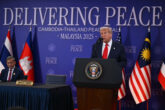June 13, 2016
Flashpoints, Escalation, and A2/AD
In this paper, CNAS Senior Fellow Dr. Mira Rapp-Hooper examines three prominent escalation scenarios in the Asia-Pacific in the context of China’s developing area-denial/anti-access capability: a seizure of the Southwest Island Chain in the East China Sea; a seizure of the Spratly Island features; and an outright invasion of Taiwan. Dr. Rapp-Hooper analyzes the differences between deliberate, inadvertent, and accidental escalations to advise policymakers on how to proscribe adversaries from achieving escalation dominance by exploiting asymmetric vulnerabilities. Dr. Rapp Hooper concludes that the best counter to deliberate and inadvertent escalations are tailored deterrence and clarified escalation thresholds respectively.
More from CNAS
-
Indo-Pacific Security / Technology & National Security
Sharper: Tech + ChinaRecent talks between President Donald Trump and Chinese Communist Party General Secretary Xi Jinping placed a spotlight on emerging technologies, from high-end chips to minera...
By Charles Horn & Sevi Silvia
-
Thailand–Cambodia Border Agreement on Shaky Ground
Trump’s initial intervention was instrumental. Yet to secure both countries’ adherence to the accord, Washington must pair continued diplomatic pressure with tangible humanita...
By Ryan Claffey
-
Indo-Pacific Security / Transatlantic Security
Why the U.S. Should Unlock Allied CooperationAmerica’s allies are cooperating in a growing variety of domains. In their recent Foreign Affairs piece, former NATO Ambassador Julie Smith and former National Security Counci...
By Andrea Kendall-Taylor & Jim Townsend
-
Indo-Pacific Security / Technology & National Security
CNAS Insights | The Cost of Silence on China’s Cyber AggressionJust weeks before the much anticipated meeting between President Donald Trump and General Secretary Xi Jinping, the United States discovered yet another major China-backed cyb...
By Morgan Peirce





